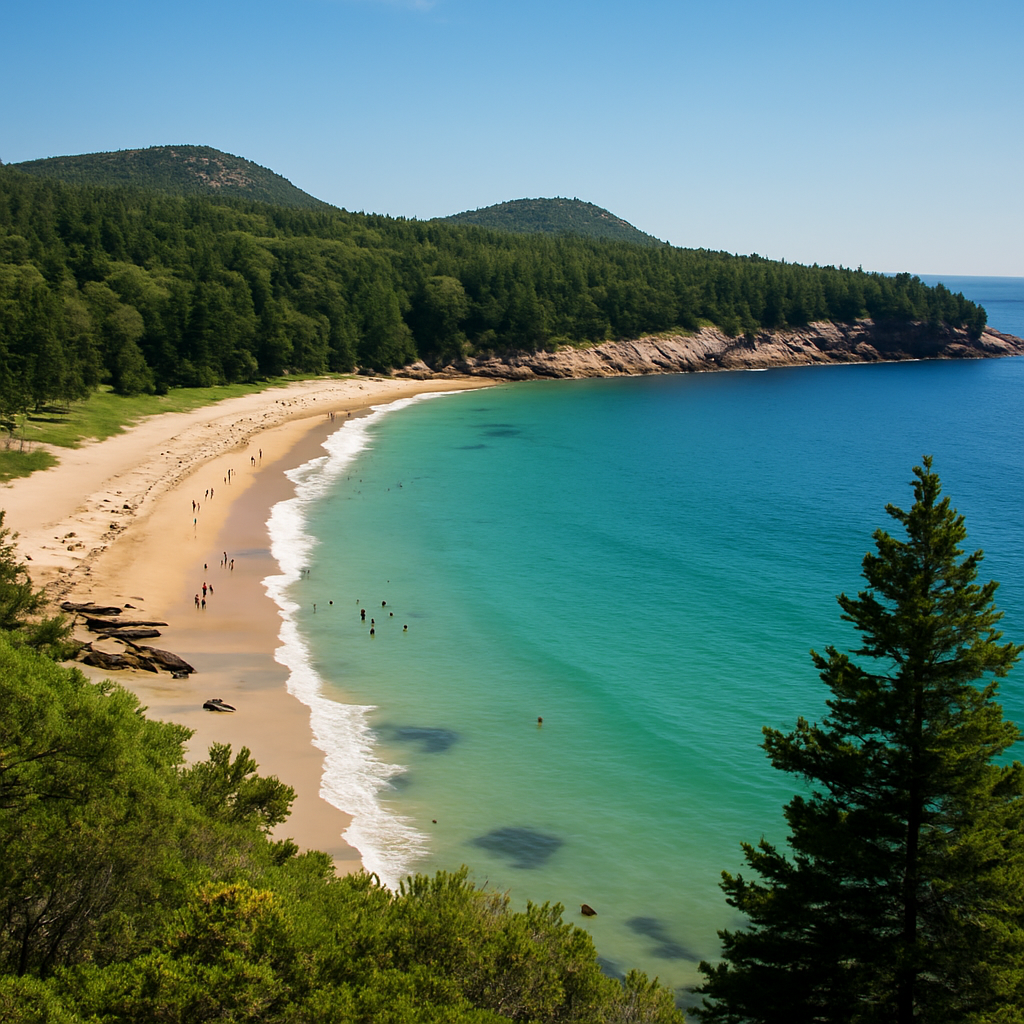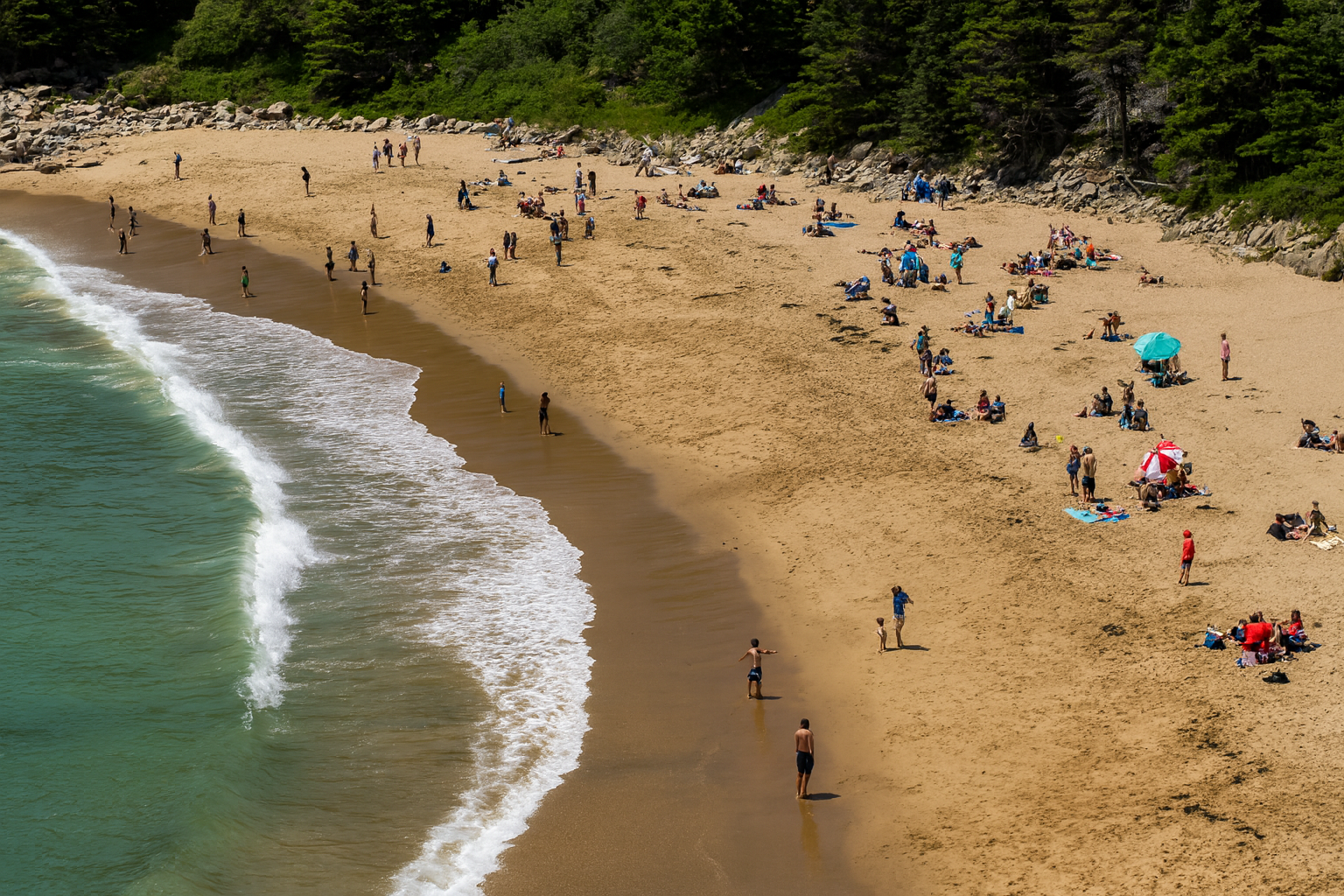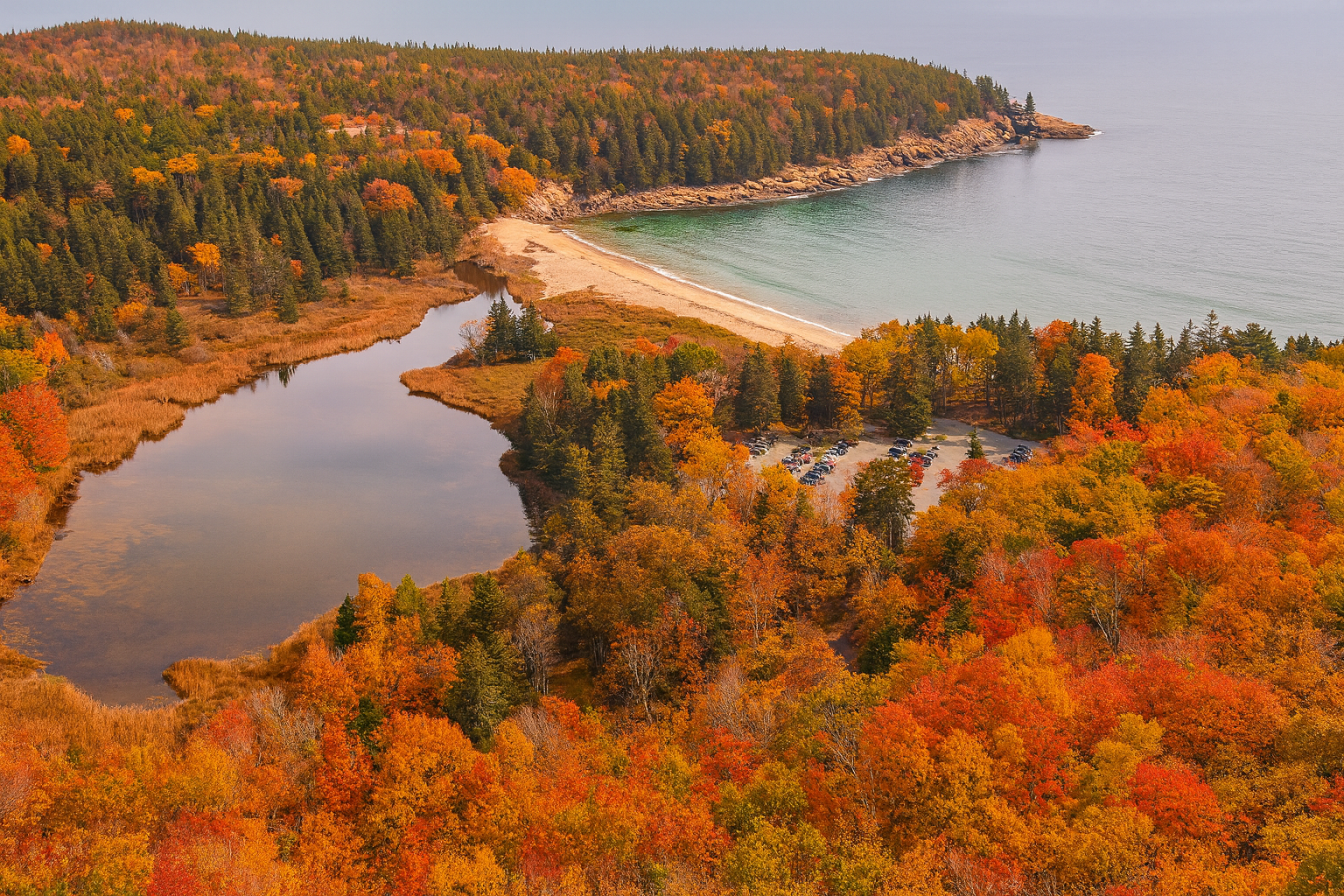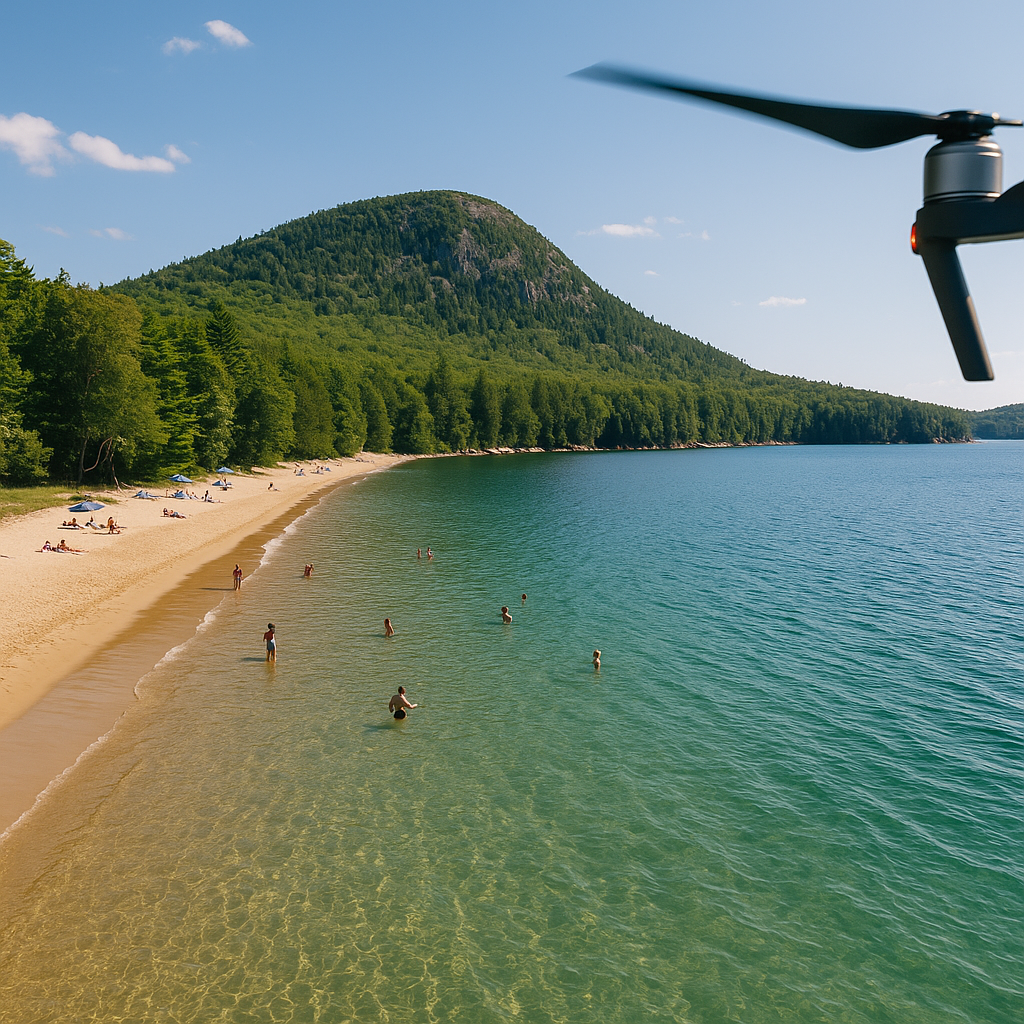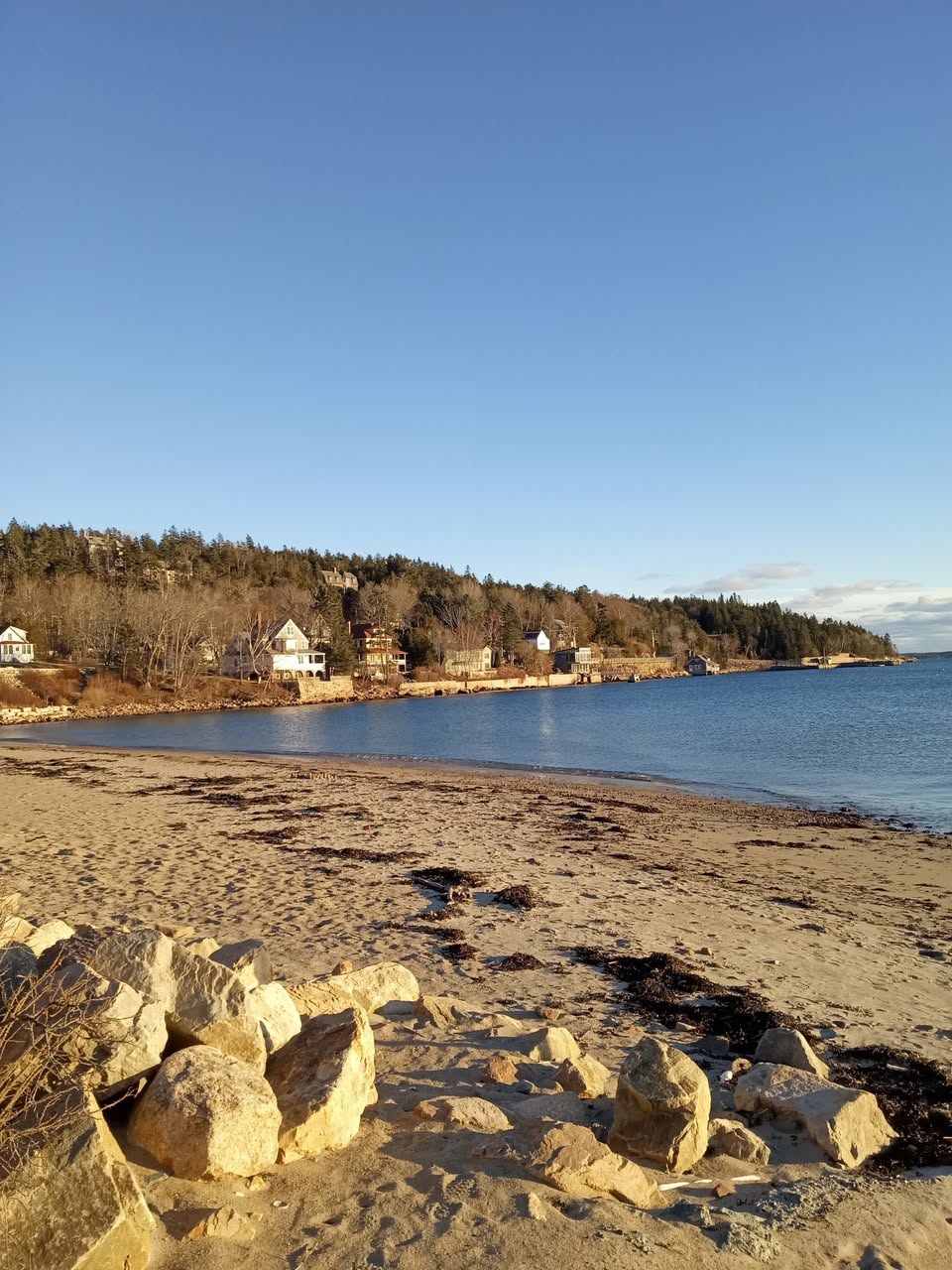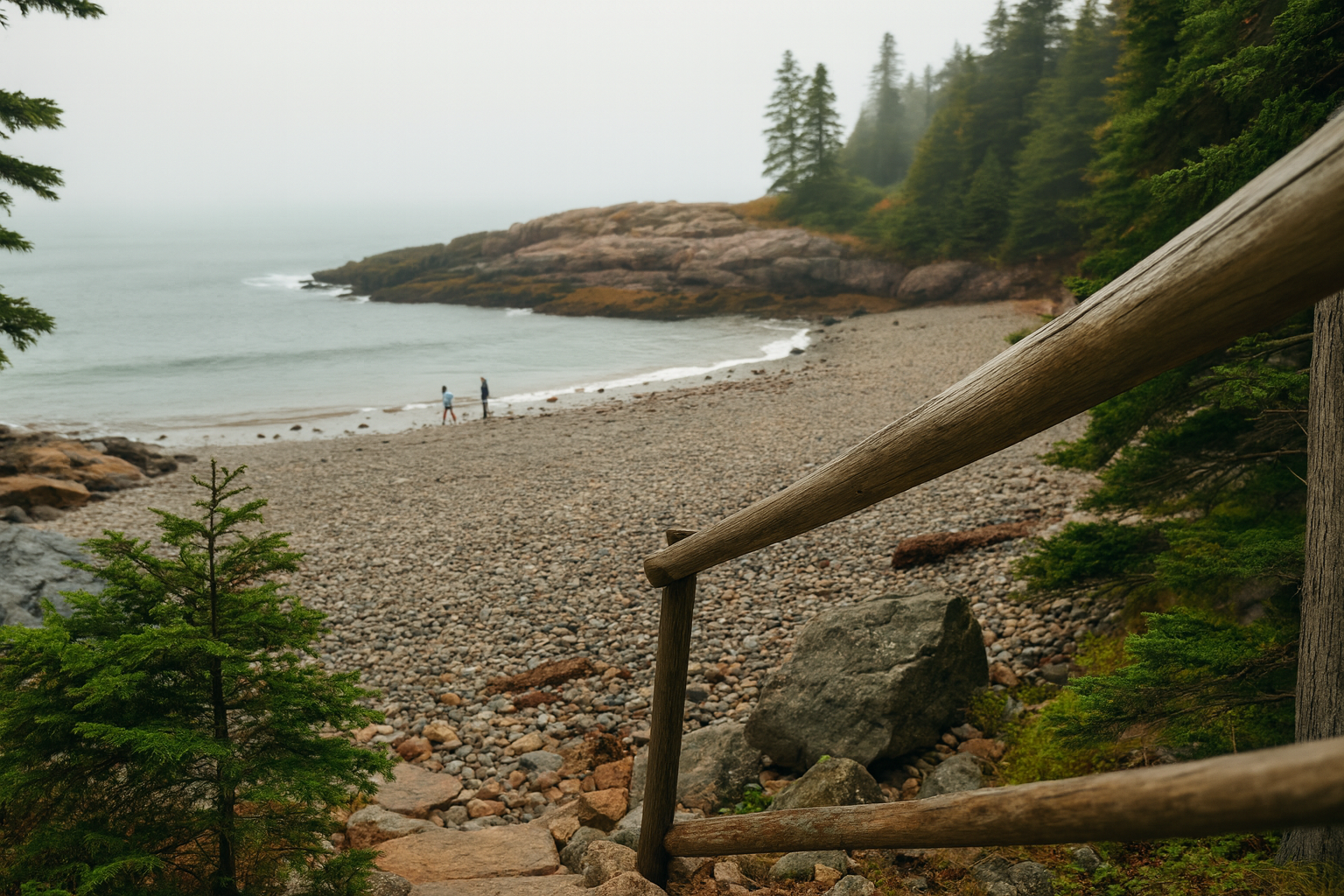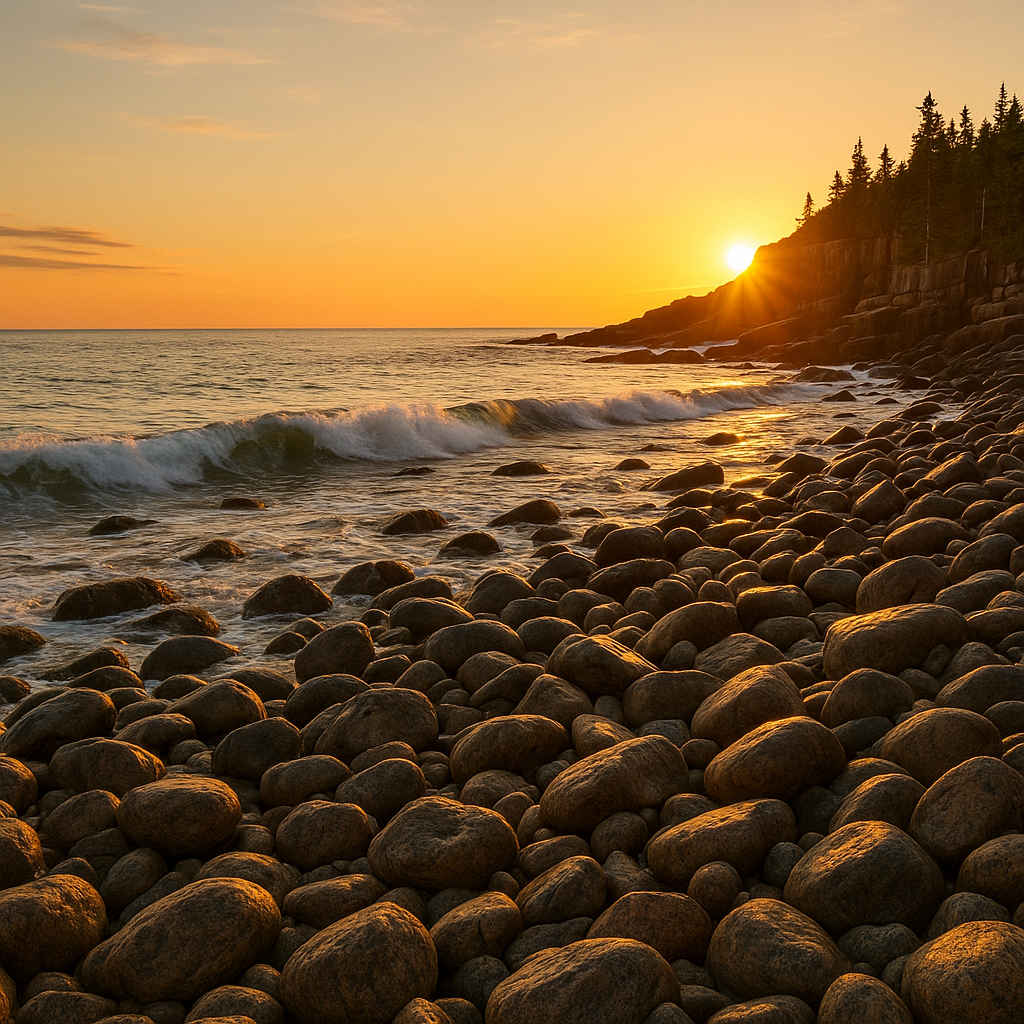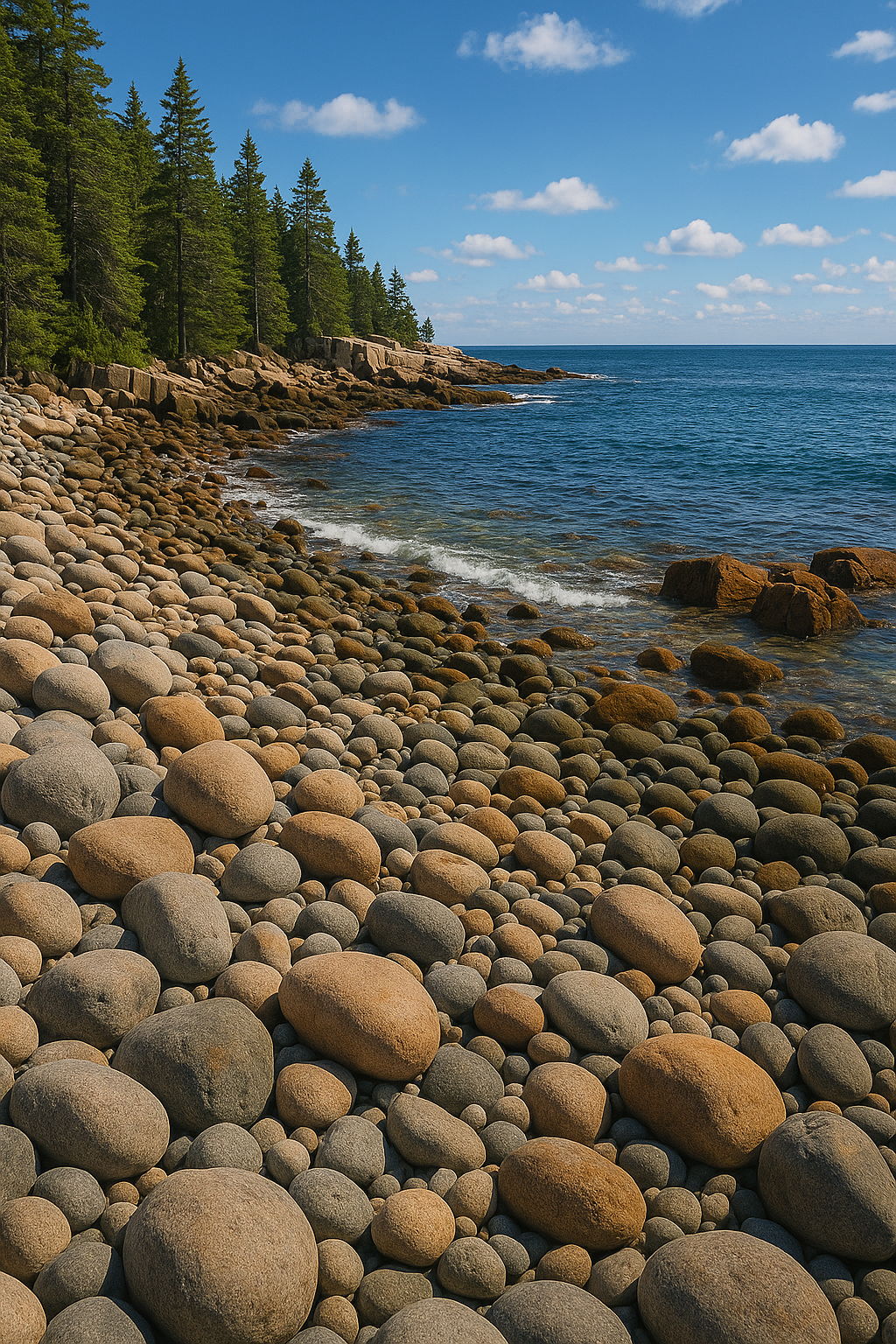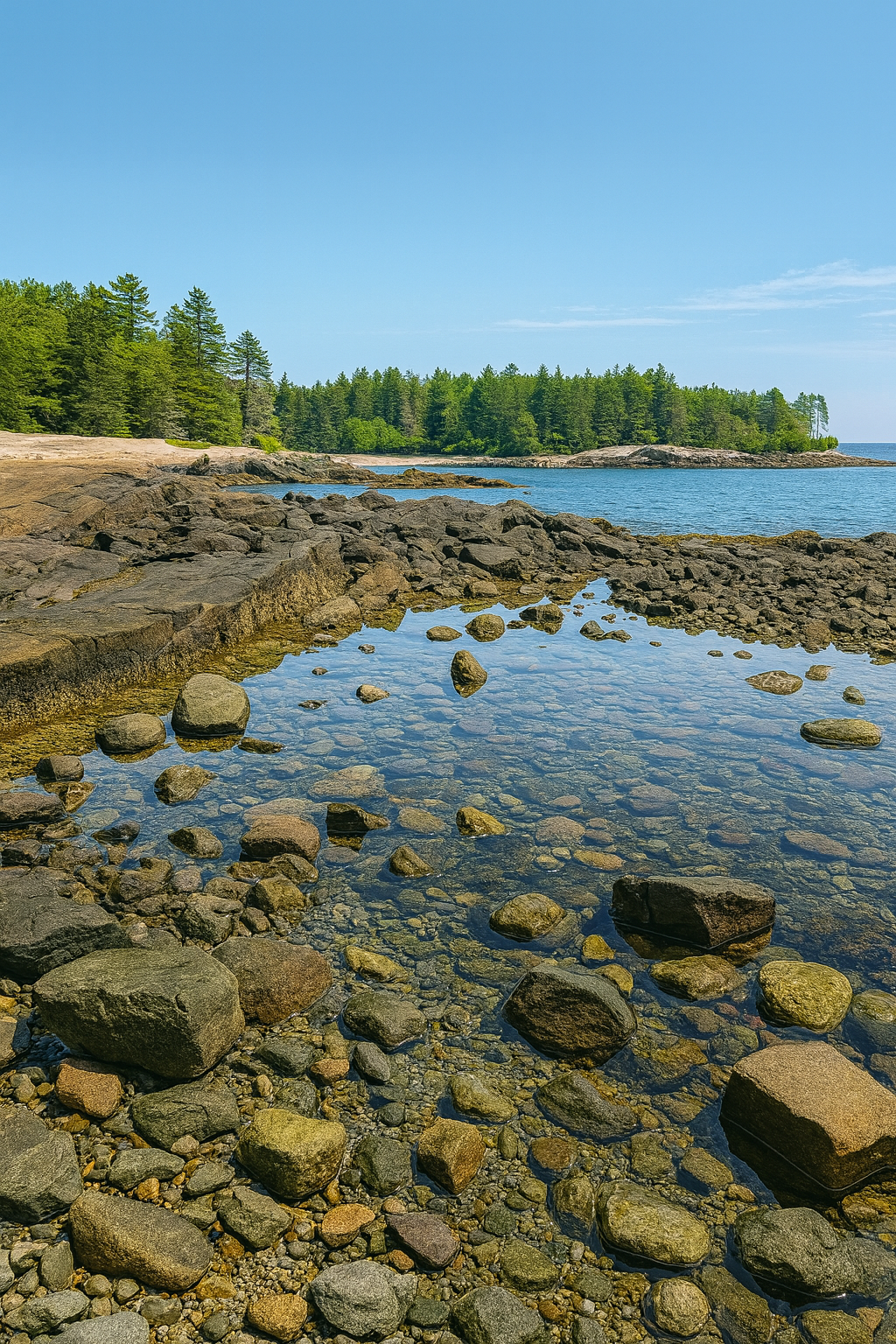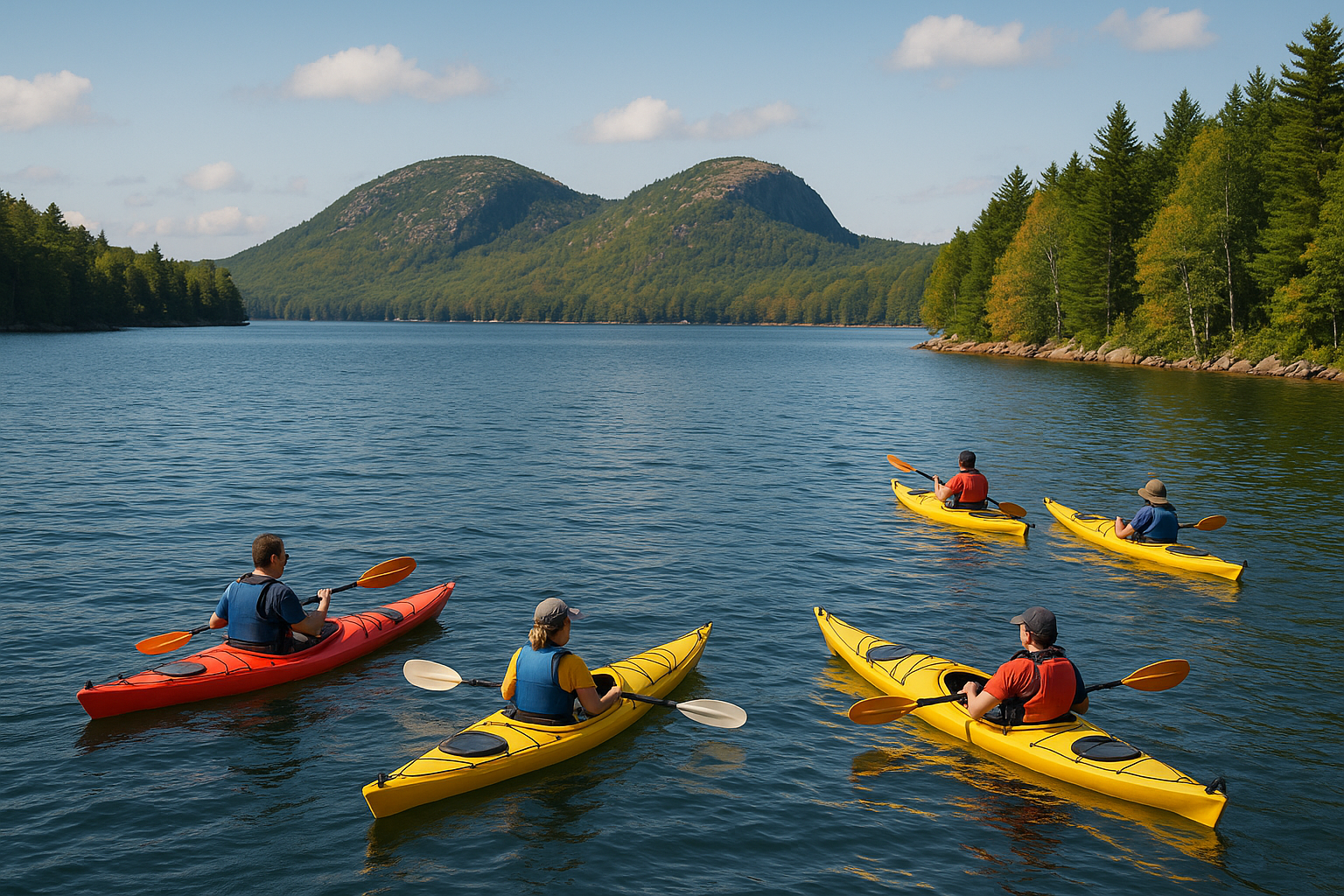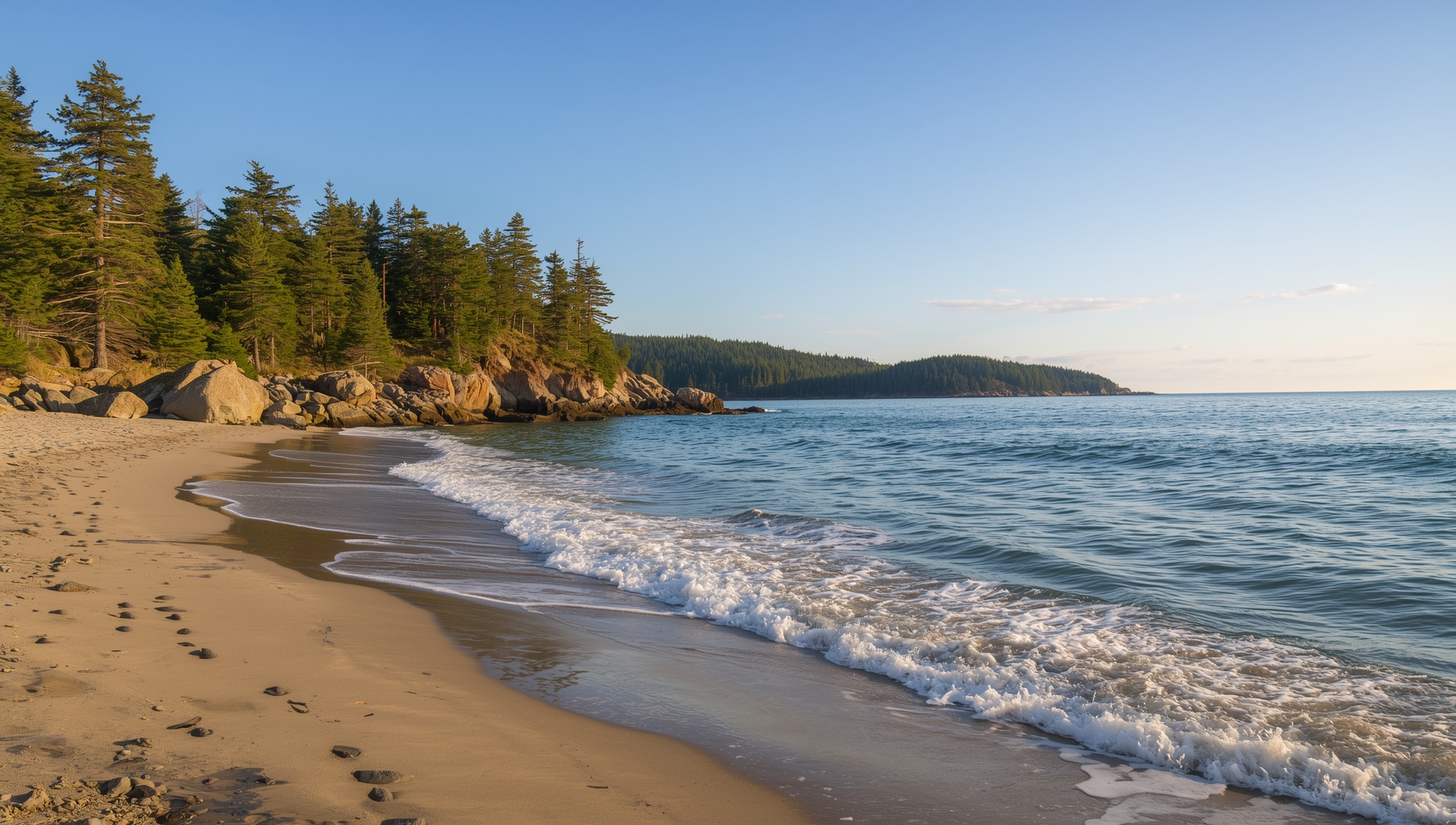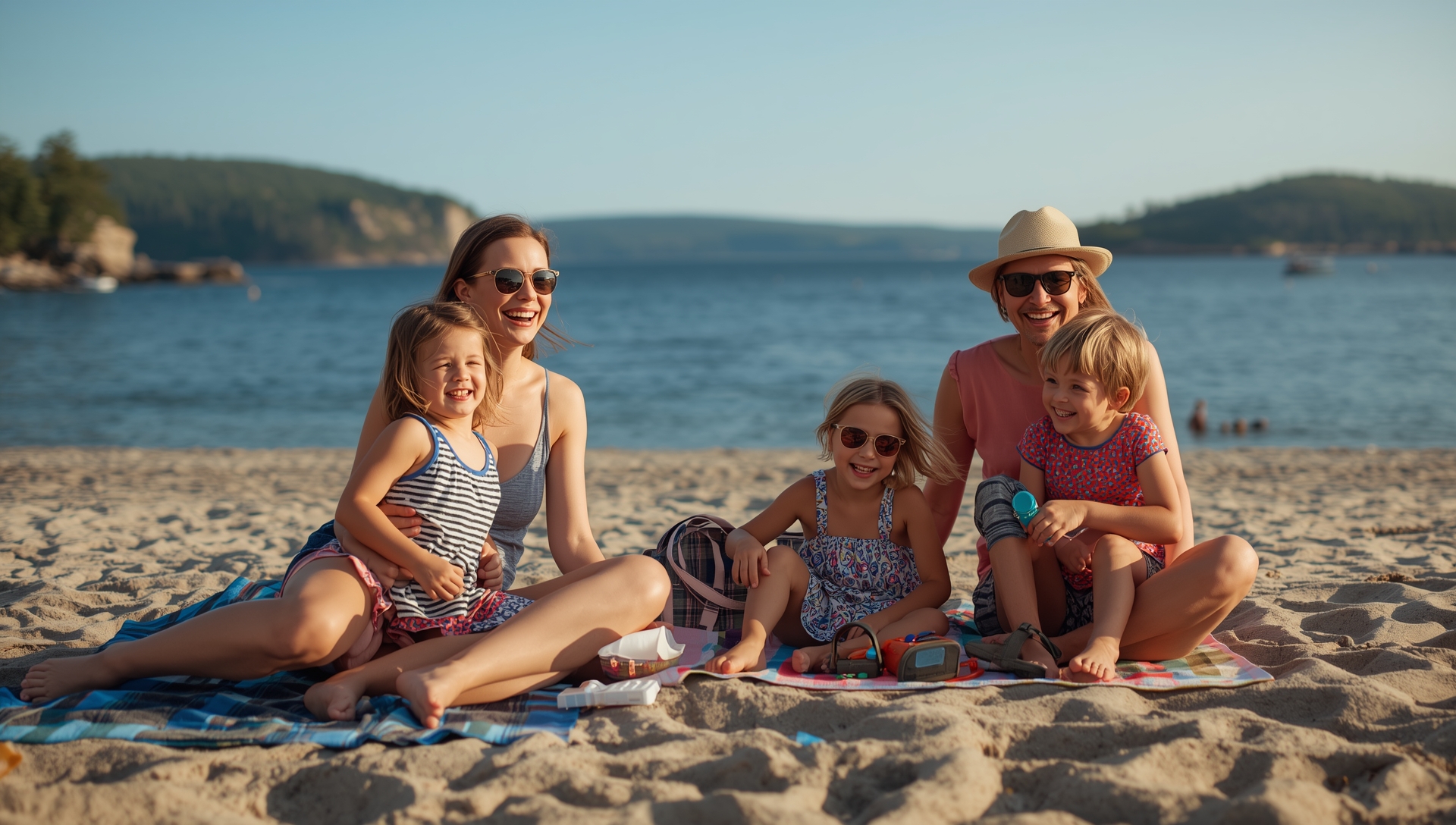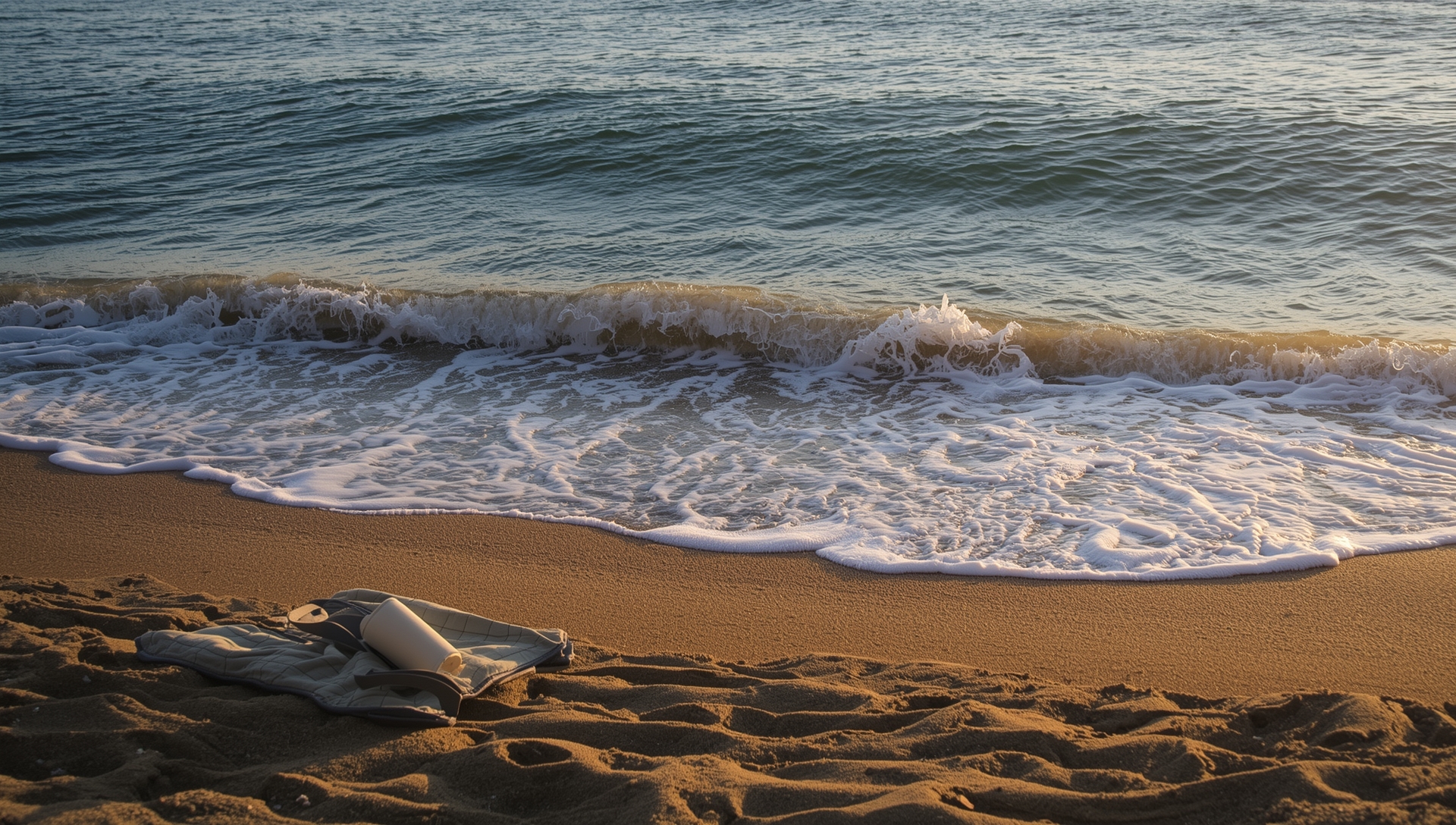Beaches in Acadia National Park
Discover the Coastal Beauty of Acadia’s Shores
Acadia National Park’s coastline is a masterpiece of contrast — where jagged granite cliffs meet soft sand and rolling surf. Though best known for its mountain peaks and scenic drives, the park’s beaches tell a gentler story of Maine’s wild Atlantic edge. Here, visitors find both drama and peace: waves pounding against the rocks one moment, and quiet coves tucked away from the crowds the next.
Beaches in Acadia National Park range from the golden sands of Sand Beach, framed by cliffs and evergreens, to the calm, freshwater shallows of Echo Lake Beach — a summer favorite for families and swimmers. Others, like Hunters Beach and Boulder Beach, invite exploration through smooth cobblestones and tide pools alive with marine life.
You don’t need to swim to enjoy these places. Simply standing barefoot on the shore, breathing the salt air, and listening to the rhythmic surf can feel like stepping into another world. Whether you’re chasing sunrise light, photographing reflections at low tide, or seeking a quiet moment between hikes, the beaches of Acadia are places to pause — where the ocean’s pulse meets the heart of Maine’s most treasured national park.
• Sand Beach Acadia National Park — golden sand and ocean views framed by granite cliffs.
• Echo Lake Beach — calm freshwater swimming area surrounded by forest and mountain views.
• Hunters Beach & Boulder Beach — tranquil coves and tide pools perfect for exploring.
• Seal Harbor Beach — a peaceful shoreline near the village, ideal for quiet walks.
• Experience the variety of beaches in Acadia National Park — from ocean surf to secluded coves — each revealing a different side of Maine’s coast.
Sand Beach Acadia – The Crown Jewel of Beaches in Acadia National Park
Tucked between steep granite headlands and washed by the cool Atlantic, Sand Beach Acadia National Park is often called the crown jewel of the park’s coastline — and it’s easy to see why. Though modest in size at just 290 yards long, this crescent of golden sand captures everything that defines Acadia: the raw meeting of land and sea, the contrast of color and texture, and the sense of wild calm that lingers long after you leave. Framed by forested cliffs, it feels both intimate and expansive, a natural amphitheatre where the surf provides the soundtrack. The sand glows pale gold in sunlight, its soft texture created by crushed shells and ancient geological forces.
The water here rarely climbs above 55°F, even at the height of summer. Yet this brisk temperature only seems to add to its charm. Swimmers wade in laughing, photographers crouch low to catch reflections on the wet shoreline, and children race in and out of the waves, squealing at the chill. For others, the experience is quieter — a walk along the tide line, the rhythmic crash of the surf, and the salt air filling the lungs. Every tide redraws the beach, leaving delicate ripples and mirror-like shallows that catch the morning light.
Sand Beach is also one of the most accessible and well-connected beaches in Acadia National Park. The main parking area sits directly off the Park Loop Road, making it a favorite first stop for visitors. From here, two of the park’s most scenic walks begin. The Ocean Path Trail traces the coastline past Thunder Hole and Monument Cove toward Otter Cliff, while the Great Head Trail climbs through spruce forest to an elevated headland offering sweeping views of Frenchman Bay. These trails make Sand Beach both a destination and a starting point — the perfect blend of ocean, forest, and mountain all in one place.
Whether you visit at sunrise for its golden calm, at midday for the lively bustle of families and hikers, or in the evening when mist drifts through the pines, Sand Beach always feels renewed. It’s a place that seems to shift with the light and tide — part sanctuary, part spectacle — and the perfect introduction to the coastal wonders of the incredible beaches in Acadia National Park.
Best for: Scenic ocean views, sunrise photography, coastal hikes
Tip: Arrive before 9 a.m. in summer to secure parking and enjoy the peaceful morning atmosphere before the crowds arrive.
• Location: Along Park Loop Road on Mount Desert Island, Acadia National Park.
• Beach Length: Approx. 290 yards of soft, shell-based sand nestled between granite headlands.
• Water Temperature: Rarely above 55 °F (13 °C), even in August — refreshing for swimmers and surfers.
• Access Points: Direct parking area and trailheads for Ocean Path and Great Head Trail.
• Highlights: Golden sand, turquoise Atlantic waves, spruce-lined cliffs, and panoramic views of Frenchman Bay.
• Best For: Photography, coastal walks, sunrise light, and family picnics.
• Tip: Arrive before 9 a.m. in summer for parking and peace before tour buses arrive.
Echo Lake Beach Acadia – Freshwater Fun Inside the Park
While most beaches in Acadia National Park face the chilly Atlantic, Echo Lake Beach Acadia offers a warm, freshwater alternative that feels like a hidden retreat. Located on the western side of Mount Desert Island—often called the park’s “quiet side”—this sandy stretch is one of the few places amongst the beaches in Acadia National Park where you can enjoy a swim without braving icy surf. The water is calm, the setting serene, and the view unforgettable.
Echo Lake sits cradled between forested slopes and the granite rise of Beech Mountain, creating a landscape that feels more like an alpine lake than a coastal one. On sunny days, the surface shimmers in shades of turquoise and green, reflecting pines and clouds drifting overhead. Families spread out along the sand, picnicking beneath the trees while children splash safely in the shallows. Because the lake’s temperature stays much warmer than the ocean, it’s a favorite spot for visitors seeking swimming in the beaches in Acadia National Park without the Atlantic’s bracing chill.
The beach itself is about 300 yards long, managed by Acadia National Park, and typically staffed with lifeguards during the summer season. The gentle entry from shore makes it ideal for wading and floating, but deeper sections appear quickly farther out, so even strong swimmers are wise to stay alert. Behind the beach, wooded paths lead toward Beech Mountain Trail, a moderate hike that rewards you with sweeping views of both the lake below and the distant sea—a perfect combination of inland tranquility and ocean horizon.
In autumn, Echo Lake Beach Maine transforms into one of the park’s most photogenic spots. The surrounding hills ignite with color—fiery reds, golds, and ambers mirrored perfectly in the still water. Photographers arrive at dawn to capture mist rising from the surface, while late-afternoon sun bathes the entire shoreline in copper light. Whether you visit to swim, hike, or simply unwind, Echo Lake Beach Acadia captures the quiet charm that defines the western side of the park—less crowded, more peaceful, and every bit as beautiful as the famous ocean beaches.
Best for: Swimming, picnics, family-friendly relaxation
Tip: Arrive mid-morning for parking and shade; the lot fills quickly on warm days.
• Setting: Nestled on the quieter western side of Mount Desert Island inside Acadia National Park.
• Vibe: Calm, freshwater swimming spot surrounded by forested cliffs and soft sand.
• Why Visit: Warmer water than the Atlantic, perfect for relaxed swimming and family days out.
• Scenic Backdrop: Beech Mountain rises dramatically behind the beach, ideal for photography.
• Nearby Trails: Easy access to Beech Mountain Trail and Canada Cliffs Trail for panoramic views.
• Facilities: Lifeguards in summer, restrooms, and shaded picnic areas.
• Best Tip: Arrive early for parking — afternoons are busiest when the lake is warmest.
Echo Lake Beach Acadia blends natural beauty with gentle recreation — a serene freshwater escape that contrasts beautifully with the wilder ocean beaches nearby.
Seal Harbor Beach, Maine – Just Outside Acadia’s Borders
Seal Harbor Beach Maine sits just beyond the southeastern edge of Acadia National Park, nestled in the postcard-worthy village of Seal Harbor. Though it’s not officially part of the park, most travelers count it among the must-see coastal stops during their Acadia itinerary. The reason is simple — this sandy crescent blends small-town charm with tranquil seaside scenery that feels like an extension of Acadia itself.
For those exploring the beaches in Acadia National Park, Seal Harbor Beach makes a lovely complement. It captures the same gentle coastal atmosphere found throughout the park’s shoreline, yet offers a quiet, village-based twist on the experience.
The beach sits right beside the harbor where fishing boats and sleek yachts share the same calm waters. Early in the morning, the scene feels almost cinematic — gulls cry overhead, mist drifts across the water, and the rising sun casts gold over the anchored sailboats. By midday, families gather with picnic baskets and beach towels, enjoying one of the rare sandy stretches on Mount Desert Island that’s easy to reach without a long drive. At low tide, the water recedes to reveal tidepools filled with crabs, shells, and seaweed — a favorite discovery zone for kids and photographers alike.
Just beyond the sand, the village of Seal Harbor unfolds with a handful of shops, cafés, and a yacht club that adds a dash of coastal elegance. Visitors often stop for lunch or an ice cream before or after their beach stroll. It’s this blend of natural beauty and convenience that makes Seal Harbor Beach feel special — the perfect in-between spot for those who want a relaxing break from Acadia’s rugged trails without leaving the scenery behind.
The beaches in Acadia National Park are known for their natural serenity, and Seal Harbor Beach offers a taste of that same beauty, paired with easy access to village comforts.
The beach is small but scenic, offering just enough space for quiet sunbathing and shoreline walks. Locals love it for its easy access and safe, shallow entry, while visitors appreciate its proximity to Jordan Pond, Wildwood Stables, and other nearby attractions within the park. From this side of the island, you can easily continue along Route 3 to explore other gems like Otter Cliff and Thunder Hole.
Seal Harbor Beach might not bear the official “Acadia National Park” title, but it captures everything visitors love about this region — maritime charm, rugged coastline, and the peaceful rhythm of waves meeting the shore.
Best for: Tidepooling, relaxing with village amenities nearby.
Tip: Check the tide charts — low tide is best for walking and exploring.
• Location: Just outside Acadia National Park in the village of Seal Harbor, Mount Desert Island.
• Vibe: Peaceful harbor setting with a true small-town Maine atmosphere.
• Best for: Tidepooling, family walks, and combining beach time with local dining.
• Scenery: Golden sand, anchored sailboats, and afternoon light over the yacht club.
• Access: Steps from parking, shops, and the Seal Harbor Maine restaurants.
• Nearby: Jordan Pond, Wildwood Stables, and Otter Cliff are all short drives away.
• Tip: Visit at low tide for exploring sandbars and tidepools.
Seal Harbor Beach Maine blends seaside relaxation with the easy charm of a coastal village — a hidden favorite just beyond Acadia’s gates.
Little Hunters Beach Maine – The Pebble Cove Treasure
You could easily drive right past the small turnoff to Little Hunters Beach Maine without realizing one of Acadia’s most enchanting coves lies just beyond the trees. Tucked away along the Park Loop Road between Otter Cliff and Blackwoods Campground, this tiny inlet remains one of the park’s best-kept secrets. It doesn’t reveal itself easily — visitors must descend a short wooden stairway that winds down through spruce and fir, the scent of pine and salt mingling in the air. At the bottom, instead of sand, you’ll find a shore made entirely of smooth, rounded cobblestones.
Among the many beaches in Acadia National Park, Little Hunters Beach stands out for its hidden charm and distinctive soundscape — a tranquil escape that feels worlds away from the park’s busier attractions.
These stones are the soul of Little Hunters Beach. Polished by centuries of tumbling waves, they range in color from deep charcoal and rust to pale gray and green, forming a natural mosaic that seems to shift with the light. When the tide rolls in, the waves lift and drop them in rhythm, creating a soft, musical clatter that echoes through the cove. It’s a sound unlike any other on Mount Desert Island — a kind of ocean lullaby that instantly quiets the mind.
Because the beach is hidden from the road, it remains far less crowded than nearby Sand Beach or Thunder Hole. Even in the height of summer, you might find only a handful of visitors here, quietly photographing or sitting on driftwood to listen to the tide. It’s a place that rewards stillness. The overhanging cliffs and dark spruce canopy lend it an atmosphere of calm isolation — the kind of coastal nook where time feels suspended.

Like many beaches in Acadia National Park, its appeal isn’t about swimming or sunbathing but about connection — the feel of the stones, the rhythm of the surf, and the beauty of Maine’s raw Atlantic coast.
While the beach’s beauty is undeniable, it’s not ideal for swimming or wading. The cobblestones shift unpredictably underfoot, and the waves can be rough when the wind comes off the Atlantic. Instead, Little Hunters Beach Maine invites a slower kind of exploration: feeling the cool stones in your hand, noticing how each one is different, or watching the light flicker on the wet rocks as clouds drift overhead. For photographers, this interplay of texture, color, and motion is a dream — every tide and season brings a new perspective.
In autumn, golden foliage frames the cove, while winter storms turn it into a dramatic scene of crashing waves and mist. Early morning or late afternoon light adds warmth to the stones, creating ideal conditions for capturing the beach’s subtle beauty.
Best for: Solitude, unique textures, and coastal photography.
Tip: The cobblestones shift underfoot — wear sturdy shoes and take your time descending the steps. Those who do are rewarded with one of Acadia’s most peaceful and evocative spots, a place where the rhythm of the ocean writes its own timeless song.
• Hidden along Park Loop Road between Otter Cliff and Blackwoods Campground.
• Known for its smooth cobblestone shore instead of sand.
• Waves create a soothing “click and clatter” sound as they move the stones.
• Accessed by a wooden stairway winding through spruce and fir trees.
• Offers quiet seclusion even in peak summer months.
• Best viewed at low tide when more of the cove is visible.
• Not suitable for swimming — stones shift and waves can be strong.
• A favorite spot for photographers seeking unique textures and light.
• Morning and evening light highlight the stones’ rich natural tones.
• Close to Thunder Hole, Otter Cliff, and Sand Beach for easy exploring.
Boulder Beach Acadia – Sunrise at the Water’s Edge
Among all the coastal gems in Acadia National Park, Boulder Beach Acadia might be the most enchanting place to greet the sunrise. Just a short distance from Otter Cliff along the Park Loop Road, it offers one of the most photogenic and atmospheric scenes in the park. The beach itself is unlike the sandy stretches elsewhere — instead, it’s covered in perfectly rounded granite stones, smoothed by centuries of waves and tides. When dawn breaks, the light transforms everything, washing the rocks in shades of pink, amber, and gold while the sound of the Atlantic fills the air. Like the other beaches in Acadia National Park, Boulder Beach showcases the raw meeting of ocean and granite that defines this coastal landscape — powerful, untamed, and endlessly inspiring.
At first light, the world feels suspended in stillness. The sky softens from deep blue to rose and orange, mirrored in the wet stones that shimmer like polished glass. As the sun lifts higher, Boulder Beach awakens — waves tumble over the rocks, sea spray glistens, and the massive form of Otter Cliff rises dramatically in the background. It’s no wonder this location has become a favorite among photographers and artists alike. Each sunrise brings something different, shaped by the season, the weather, and the tide. Even seasoned visitors find that no two mornings here are ever the same. Because the stones are smooth and uneven, it’s best to move carefully — especially before dawn, when the light is still dim.
The beach is not suitable for swimming or lounging, but that’s not its purpose. Boulder Beach Acadia is a place for witnessing — for standing quietly and letting nature unfold its rhythm. The feel of the cold sea air, the rumble of distant waves, and the scent of salt and pine from the nearby cliffs combine into a sensory experience that feels almost sacred. It’s the kind of moment that captures what makes the beaches in Acadia National Park so memorable: their ability to evoke awe without crowds or distractions. Here, time seems to slow, the sound of the waves becomes meditative, and the sunrise feels deeply personal.
If you plan to photograph the sunrise, arrive well before first light. Parking fills quickly during peak months, and the best colors often appear in the 20 minutes before the sun actually breaks the horizon. Low tide is the ideal time to visit; when the tide rises, much of the rocky shoreline vanishes under the surf. A partly cloudy sky creates the most striking contrast, with the clouds catching the morning glow and reflecting it across the water. Visiting Boulder Beach Maine is not just about the view — it’s about the feeling of standing at the edge of the day’s beginning, surrounded by beauty carved over millennia.
• Found along Park Loop Road between Otter Cliff and Thunder Hole.
• Famous for sunrise photography with glowing granite stones.
• Best viewed at low tide when more of the boulders are exposed.
• Waves create a rhythmic crash perfect for long-exposure shots.
• Not ideal for swimming — focus on the view and atmosphere.
• Arrive early for the best light and fewer crowds.
Hunter’s Beach Maine – Forest Path to a Pebble Shore
There’s something quietly magical about Hunter’s Beach Maine, one of Acadia National Park’s most peaceful and lesser-known spots. Reached by a short walk through spruce and fir forest, the path begins just off Route 3, leading visitors along a gentle, shaded trail. The air feels cool and earthy, filled with the scent of pine needles and salt drifting in from the nearby ocean. As you follow the narrow track, the soundscape gradually changes — the rustle of leaves gives way to the soft rumble of distant surf. Then, suddenly, the trees part, and the world opens into a serene pebble cove where a freshwater stream meets the sea.
The first glimpse of the shore is always breathtaking. Instead of sand, Hunter’s Beach Acadia is lined with thousands of smooth, colorful cobblestones — reds, grays, greens, and blacks — each shaped by countless tides. These rounded stones create a natural mosaic that shifts slightly with every wave. The small stream that winds through the forest empties across them, cutting a thin, clear ribbon of freshwater that sparkles in the sunlight before vanishing into the Atlantic. It’s the kind of scene that feels untouched, as if time has paused just for you to take it in. Among all the beaches in Acadia National Park, this one stands apart for its forested approach and rare blend of woodland and ocean — two ecosystems meeting in quiet harmony.
This is not a place for swimming or sunbathing. The stones are too uneven for lounging, and the surf, though beautiful, can be unpredictable. But that’s not what draws people here. Hunter’s Beach Maine is a sanctuary — a place to sit quietly on a piece of driftwood, listen to the movement of the waves, and watch gulls and cormorants patrol the rocky shore. Small tidepools form among the stones, home to barnacles, periwinkles, and tiny crabs that make delightful discoveries for careful explorers. The combination of forest, stream, and ocean gives Hunter’s Beach a meditative atmosphere unlike any other in Acadia. The gentle rhythm of the water, the filtered light through evergreens, and the scent of the sea create a sense of calm that feels miles away from busier park destinations. Photographers love the contrast of the dark tree canopy against the bright, open horizon, while families and solo visitors come simply to enjoy the quiet beauty.
If you plan to visit, bring sturdy shoes for walking across the stones and a camera for capturing the play of light and shadow. In late spring and summer, a bit of bug spray can make the shaded forest trail more comfortable. Whether you come for tidepooling, birdwatching, or quiet reflection, Hunter’s Beach Maine rewards those who slow down and listen — a perfect reminder that some of Acadia’s greatest treasures are its most tranquil ones.
Best for: Nature walks, tidepooling, birdwatching
Tip: Bug spray is especially useful in late spring and summer along the shaded forest trail.
• A short forest trail leads to a secluded cobblestone cove.
• Freshwater stream meets the Atlantic at Hunters Beach Acadia.
• Ideal for tidepooling, quiet reflection, and photography.
• Surrounded by spruce and fir forest alive with birdlife.
• Bring sturdy shoes — stones can be slick after rain.
• One of Acadia’s most peaceful shoreline walks.
Compass Harbor
Just a short walk from downtown Bar Harbor, Compass Harbor feels like a world apart. The trailhead sits conveniently off Route 3, yet within a few steps you leave behind the hum of town and step into a peaceful pocket of forest. Spruce, fir, and hardwood trees line the path, their branches forming a soft canopy overhead. The air smells of pine and salt, and the distant sound of gulls gives an early hint that the ocean is near. It’s one of those walks where your breathing slows, your pace eases, and the quiet rhythm of Acadia begins to take over.
The path to Compass Harbor Acadia is short and easy, winding just half a mile to the coast — perfect for families, photographers, and anyone seeking a gentle nature break. Children love exploring the tidepools, crouching over tiny periwinkles and crabs that make their homes in the rocks. Adults, meanwhile, tend to linger along the granite ledges that frame the cove, mesmerized by the view across Frenchman Bay. On calm days, the water moves softly against the stones, while after storms, waves thunder in, splashing dramatically against the rock outcrops. It’s an ever-changing scene, one that perfectly captures the spirit of Acadia’s rugged shoreline.
Compass Harbor’s appeal lies not only in its scenery but in its sense of tranquility. Even though it’s minutes from Bar Harbor, it rarely feels busy. Locals and returning visitors often describe it as a “reset button” — a place to clear the mind, breathe, and reconnect with nature. The cove’s shape creates small pockets of privacy where you can sit quietly on a ledge, sketch, journal, or simply listen to the rhythmic wash of the sea. In the early morning, the light glows pink and gold across the bay, and at sunset, the fading light gives the cliffs a soft, warm tone that feels almost painterly.
Few places in Acadia blend accessibility and serenity as seamlessly as Compass Harbor. For those who want a taste of the park’s natural beauty without a long drive or strenuous hike, this is the ideal spot. It’s also a place rich with quiet history — nearby once stood the home of George B. Dorr, known as the “Father of Acadia,” whose vision and dedication helped create the national park itself. Walking here, it’s easy to imagine why he chose this cove as his retreat. More than just a short coastal path, Compass Harbor is a reminder that Acadia’s wildness begins right at Bar Harbor’s doorstep — ready to welcome anyone willing to slow down and wander.
Seawall Acadia National Park – Rugged Beauty on the Western Shore
On Mount Desert Island’s quiet southwestern side, Seawall Acadia National Park reveals one of the most powerful and unrefined stretches of coastline in Maine. Unlike the sandy shores found elsewhere in the park, Seawall’s landscape is made entirely of granite boulders and ledges, forming a natural barrier that runs for more than a mile along the sea. Centuries of pounding waves have shaped this enormous wall of stone into a place where nature’s strength is always on display. It’s the kind of shoreline that doesn’t just invite you to look — it invites you to feel.
At low tide, the rugged expanse of Seawall Acadia transforms into an outdoor classroom of color and texture. Shallow tidepools fill the spaces between the rocks, revealing barnacles, mussels, seaweed, and tiny crabs scuttling through the clear water. Families often spread out across the stones, each person discovering something new — a shell, a glistening bit of sea glass, or a small marine creature hidden beneath the kelp. The sunlight dances on the wet granite, turning the entire wall into a living mosaic of reflection and detail.
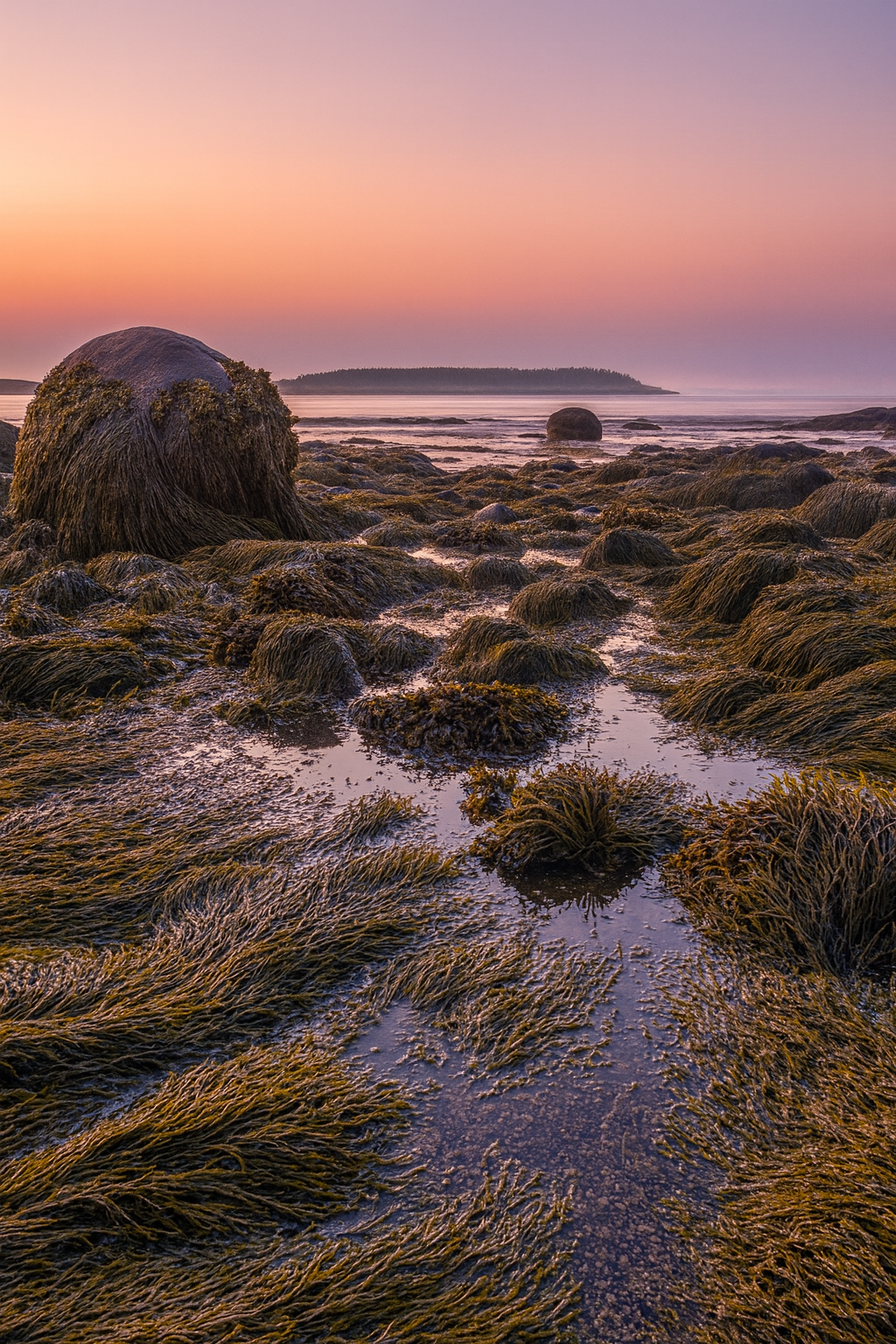
As the tide rises, acadia seawall takes on a completely different mood. The calm exploration of tidepools gives way to a thunderous performance as waves crash hard against the rocks, sending spray into the air and echoing through the forest behind. Standing on the higher ledges, you can feel the vibration of the surf beneath your feet. It’s one of the few places in the park where the ocean feels close enough to touch, yet vast enough to remind you how wild this coast truly is.
Visitors to Seawall Acadia national park maine often describe it as Acadia’s untamed edge — raw, powerful, and refreshingly uncrowded. Whether you come for tidepooling at low tide or to watch the waves roar at sunset, Seawall offers an experience that’s both humbling and energizing. It’s not a beach for swimming or sunbathing, but for standing in awe of nature’s artistry — a place where rock, water, and sky meet in perfect, elemental balance.
Seasonal Highlights for Beaches in Acadia National Park
Each season transforms the beaches in Acadia National Park into something completely unique. From the quiet stillness of winter to the bright bustle of summer, Acadia’s coastline reflects the rhythm of the year — sometimes calm, sometimes wild, but always captivating. Whether you’re walking Boulder Beach at dawn, resting at Echo Lake on a warm afternoon, or watching the waves thunder at Seawall, every visit feels different depending on the season.
Spring in Acadia National Park brings a sense of renewal to Acadia’s shores. After months of icy seas and solitude, the coastline begins to stir again. Wildflowers bloom along the trails leading to Sand Beach and Hunters Beach, adding bursts of color to the forest paths. The air is crisp and cool, with a faint scent of salt and pine carried on the breeze. Tidepools come alive with tiny sea creatures, and photographers love this time of year for the soft morning light and lack of crowds. Beaches are quiet, wildlife is active, and every wave seems to carry the energy of a new beginning.
Summer in Acadia National Park ensures Acadia’s beaches are in full swing. Echo Lake Beach becomes a favorite for swimmers and families — its warmer freshwater is a welcome contrast to the icy Atlantic. Sand Beach, framed by cliffs and backed by mountains, draws early risers eager to beat the crowds or catch the sunrise. Kayakers and paddleboarders dot the water, while picnickers settle into shaded spots near the shore. Even the more rugged areas, like Seawall and Little Hunters Beach, hum with activity as visitors explore tidepools and enjoy the long daylight hours. Summer in Acadia is lively, full of laughter, and the ocean’s rhythm becomes the soundtrack of the season.
Acadia National Park in the Fall might be the most photogenic time to visit. The park’s forests turn gold, crimson, and orange, creating an incredible backdrop for every shoreline. Boulder Beach at sunrise becomes one of the park’s most breathtaking scenes, where autumn colors reflect on wet granite and the morning light glows off Otter Cliff. The air feels cooler and the crowds thin out, allowing for peaceful walks and quiet moments at Compass Harbor or Hunters Beach. Photographers and artists flock here during this season to capture the fleeting beauty of Acadia in its full autumn display.
Winter in Acadia National Park transforms the coast into something almost otherworldly. The beaches grow silent beneath a dusting of snow, and waves crash dramatically against the rocks. While swimming is out of the question, solitude seekers find this time of year enchanting. Standing at Seawall or Schoodic Point as snowflakes drift over the surf feels like witnessing Acadia’s wild heart at rest. It’s cold, powerful, and absolutely serene — a reminder that Acadia’s coastline is as beautiful in stillness as it is in motion.
No matter when you visit, the beaches in Acadia National Park offer something special. Each season reveals a different side of the coast — from spring’s renewal and summer’s energy to fall’s glowing colors and winter’s calm solitude. Whether you come for a sunrise photograph, a quiet walk, or a day by the water, Acadia’s shores remind you how beautifully the park changes with time. Every wave, every season, tells a new story — and all are worth experiencing.
• Spring brings cool air, wildflowers, and quiet coastal trails.
• Summer is ideal for swimming at Echo Lake Beach and sunrise walks at Sand Beach.
• Fall transforms Boulder Beach with brilliant foliage and golden light.
• Winter offers solitude, snow-dusted rocks, and dramatic Atlantic surf.
• Each season reveals a new way to experience Acadia’s shoreline.
Planning Your Acadia Beach Adventure
A visit to the beaches in Acadia National Park can be one of the most rewarding parts of your trip — as long as you plan ahead. Acadia’s coastline is incredibly diverse, ranging from the golden sand of Sand Beach to the smooth granite stones of Boulder Beach and the calm freshwater of Echo Lake Beach. Each beach has its own personality, weather patterns, and rhythms of tide, which means a little preparation can make the difference between a quick stop and a memorable day.
Parking: Summer is Acadia’s busiest season, and parking at popular coastal spots fills up fast, especially around midday. To make the most of your visit, try to arrive early in the morning or later in the afternoon when crowds thin out. The Island Explorer shuttle is a convenient, free option during the summer months, connecting key beaches and attractions while helping reduce congestion and emissions within the park.
- Tide Charts:
The ocean defines Acadia’s beaches as much as the land does, and timing your visit around the tide can completely change your experience. At low tide, rocky areas like Boulder Beach and Little Hunters Beach transform into tidepool wonderlands, full of barnacles, sea stars, and tiny crabs. Photographers love this time of day for the reflective surfaces, vibrant colors, and intricate details revealed as the water recedes. High tide, on the other hand, offers drama — crashing surf at Seawall or rolling waves at Sand Beach that seem to fill the whole bay with energy.
- Weather:
Coastal Maine’s weather can shift in minutes. Morning fog may roll in off the water, clearing to bright sunshine by midday, or the temperature may drop quickly as the afternoon breeze picks up. Dress in layers, even in summer, and bring a light waterproof jacket. A wide-brimmed hat or sun protection can also make long stays by the shore far more comfortable.
- Footwear:
Not all beaches in Acadia are soft underfoot. Even sandy stretches like Sand Beach have rocky edges, and places like Seawall or Hunters Beach are almost entirely made of smooth stones. Sturdy sandals, water shoes, or lightweight hiking shoes are ideal for navigating wet, uneven terrain safely.
- Respect Wildlife:
Acadia’s beaches are alive with creatures both large and small. Keep a respectful distance from seabirds, seals, and intertidal life, and avoid disturbing nesting areas or removing shells. By treading lightly, you help preserve the fragile coastal ecosystem that makes these places so special.
With a bit of forethought and care, your Acadia beach adventure can be both relaxing and inspiring — a day of discovery, beauty, and connection to one of America’s most remarkable coastlines.
• Arrive early or ride the Island Explorer shuttle to avoid parking stress.
• Check tide charts for tidepooling or sunrise photography spots.
• Pack layers — Maine’s weather shifts quickly by the coast.
• Wear sturdy sandals or water shoes for rocky areas.
• Observe wildlife respectfully; protect seabirds and intertidal life.
Before the Tide Rolls Out
No matter which shoreline you choose, the beaches in Acadia National Park reveal the softer side of this rugged coastal landscape. From the golden sands of Sand Beach to the smooth granite stones of Boulder Beach, every location tells its own story — shaped by tide, wind, and time. Echo Lake Beach invites families to swim and unwind, while quieter coves like Hunters Beach or Little Hunters offer moments of calm reflection among polished stones and trickling streams.
What makes these beaches so unforgettable isn’t just their scenery, but their atmosphere. Early mornings bring mist and solitude, while afternoons fill with the laughter of families, picnics, and the rhythmic sound of waves. Evenings settle gently, painting the horizon in gold and rose as the tide recedes. Each hour feels like a different world, reminding you that Acadia is alive — breathing with the ocean’s pulse.
Whether you’re exploring tidepools, photographing sunrise, or simply enjoying the salt air, Acadia’s beaches capture the essence of coastal Maine: wild, welcoming, and endlessly beautiful. They are places where you can slow down, listen, and reconnect — not just with nature, but with yourself.
So pack a towel, check the tides, and follow the call of the waves. The beaches of Acadia are waiting — and they never look the same twice.
• Every shoreline in Acadia offers its own rhythm and personality.
• Sand Beach glows at sunrise while Boulder Beach shines after the tide falls.
• Echo Lake Beach and Hunters Beach provide quiet contrast to ocean surf.
• Each season changes the light, color, and mood along the Maine coast.
• The beaches in Acadia National Park capture both beauty and belonging in every visit.
Acadia’s beaches change with every season and every wave. Each visit offers a new sound, a new color, and a fresh reason to fall in love with the coast all over again.
← Explore Acadia National Park
Ready to keep the adventure going? Dive deeper into Acadia’s history, local secrets, and stunning coastal views with these trusted guides and nearby gems:
• National Park Service – Acadia National Park
• Bar Harbor Chamber of Commerce
• Schoodic Peninsula Acadia National Park
Get the latest park stories, travel tips, and photo inspiration from Acadia and beyond. Join our growing community of explorers who love America’s wild places as much as you do.
🖋️ Sign Up
Share Your Favorite Beach in Acadia National Park
Have You Visited the Beaches of Acadia National Park?
We’d love to hear your story! Whether you walked along Boulder Beach at sunrise, swam at Sand Beach, or explored the hidden shoreline at Little Hunters Beach, every visit is unique.
Tell us what you loved most — the sound of the waves, the color of the rocks, or the peaceful views across Frenchman Bay. Include a photo or two if you have them! Your experience can help future visitors discover Acadia’s coastal beauty.
